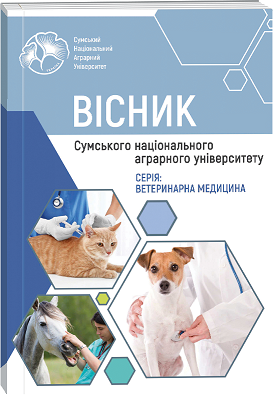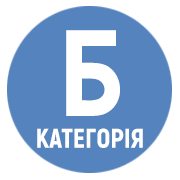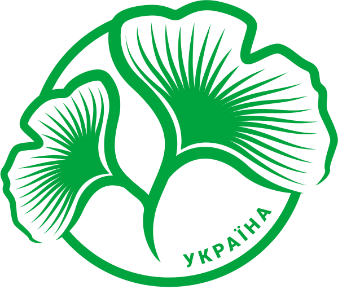DETERMINATION OF THE EFFECT OF A POVIDONE-IODINE-BASED PREPARATION ON THE QUALITY OF PRODUCTS OBTAINED FROM BROILERS AND LAYING HENS
Abstract
The Chernihiv and Sumy oblasts, are regions with endemic iodine deficiency. Therefore, it is recommended to supplement poultry feed with iodine, manganese and zinc. The aim of the study was to quantify iodine accumulation in broiler meat, table eggs and liver of laying hens using a stable concentrated iodine preparation instead of conventional potassium iodide. The research was conducted in the educational and scientific laboratory «Innovative Technologies and Food Safety and Quality» at the Faculty of Veterinary Medicine of Sumy NAU and in the field at the broiler farm «Putivlsky Broiler» and the egg farm «Sumytechnokorm», Sumy Region. The study used pre-sexed day-old chicks, which were divided into three groups of 100 individuals (50 males and 50 females) and raised together until 42 days of age. The control group received standard feed. The drug was diluted in drinking water immediately before use and administered orally at a dose of 0.02 ml per 1 kg of body weight, or 200 ml of the drug per 1000 l of water, which corresponds to 4 mg of povidone-iodine and 24 μg of sodium selenite. The course of 7 days was carried out assuming that the pH level of drinking water was at least 6-7. The addition of povidone – iodine (polyvinylpyrrolidone iodide) to drinking water is a complex of iodine with polyvinylpyrrolidone (PVP), which has a bactericidal effect on gram – positive and gram – negative bacteria, sporocidal and antiprotozoal effects (200 ml of the product per 1000 litres of drinking water), increased the iodine content of broiler meat by an average of 15 and 75 %, respectively, compared to the control group that did not receive the product. Eggs from laying hens given drinking water with povidone – iodine contained 25 and 95 % more iodine than eggs from laying hens in the control group. It was also found that administration of the drug to laying hens increased the iodine content of the hens' livers by 12,5 – 25 %. Iodine – enriched poultry meat and eggs can be recommended to the population as a functional food.
References
2. Dobrzański, Z., Górecka, H., Strzelbicka, G., Szczypel, J., & Trziszka, T. (2001). Study on enrichment of hen eggs with selenium and iodine. Electronic Journal of Polish Agricultural Universities, Animal Husbandry, 4(2). [Available online]. [Accessed 2008 February 15]. Retrieved from http://www.ejpau.media.pl/series/volume4/issue2/animal/art01.html
3. EFSA (European Food Safety Authority). (2005, February 22). Opinion of the FEEDAP Panel on the use of iodine in feedingstuffs. EFSA Journal, 233, 1–11. [Available online]. Retrieved from https://www.efsa.europa.eu/en/efsajournal/pub/233
4. Flachowsky, G. (2007). Iodine in animal nutrition and iodine transfer from feed into food of animal origin. Lohmann Information, 42(2). [Available Online]. [Accessed 2007, October 15].
5. Flynn, A., Moreiras, O., Stehle, P., Fletcher, R. J., Müller, D. J., & Rolland, V. (2003). Vitamins and minerals: a model for safe addition to foods. European journal of nutrition, 42(2), 118–130. https://doi.org/10.1007/s00394-003-0391-9
6. Fu, Z., Zhong, T., Wan, X., Xu, L., Yang, H., Han, H., & Wang, Z. (2022). Effects of Dietary Vitamin E Supplementation on Reproductive Performance, Egg Characteristics, Antioxidant Capacity, and Immune Status in Breeding Geese during the Late Laying Period. Antioxidants, 11(10), 2070. https://doi.org/10.3390/antiox11102070
7. Galobart, J., Barroeta, A. C., Cortinas, L., Baucells, M. D., & Codony, R. (2002). Accumulation of alpha-tocopherol in eggs enriched with omega3 and omega6 polyunsaturated fatty acids. Poultry science, 81(12), 1873–1876. https://doi.org/10.1093/ps/81.12.1873
8. Grossman, A. (1992). Clinical endocrinology. Blackwell Scientific Publications.
9. Gružauskas, R., Lukoševičius, L., Danius, S., et al. (2002). Eggs as a functional food. In Proceedings of the 10th Baltic Poultry Conference (pp. 18–21). Vilnius.
10. Gudavičiūtė, D., Bobinienė, R., & Sabalionytė, R. (2002). Influence of iodized water on poultry production quality. Agricultural sciences, 2, 52–56.
11. Gudavičiūtė, D., Čepulienė, R., Bobinienė, R., & Kepalienė, I. (2006). Influence of prebiotic feed additive on some physiological functions and meat quality of poultry. Agricultural sciences, 4, 63–67.
12. Hetzel, B. S., & Mano, M. T. (1989). A review of experimental studies of iodine deficiency during fetal development. The Journal of nutrition, 119(2), 145–151. https://doi.org/10.1093/jn/119.2.145
13. Jeroch, H., Eder, K., Schöne, F., Hirche, F., Böttcher, W., Šeškevičienė, J., Kluge, H., et al. (2002). Amounts of essential fatty acids, α-tocopherol, folic acid, selenium and iodine in designer eggs. International Symposium on Physiology of Livestock, 31-32. Lithuanian Veterinary Academy.
14. Karsten, H. D., Patterson, P. H., Stout, R., & Crews, G. (2010). Vitamins A, E and fatty acid composition of the eggs of caged hens and pastured hens. Renewable Agriculture and Food Systems, 25(1), 45–54. doi:10.1017/S1742170509990214.
15. Kepalienė, I., Bobinienė, R., Sirvydis, V., Miškinienė, M., Semaška, V., Čepulienė, R., Gudavičiūtė, D., & Vencius, D. (2006). Influence of stable iodine on biochemical parameters of blood and on morphology in broiler chicken. Veterinary Medicine and Zootechnics, 36(58), 39-43. Lithuanian Veterinary Academy.
16. Larsen, E., H., et al. (2002). Food additives and contaminants. Food Additives and Contaminants, 19(1), 33-46.
17. Lewis P. D. (2004). Responses of domestic fowl to excess iodine: a review. The British journal of nutrition, 91(1), 29–39. https://doi.org/10.1079/bjn20031017
18. Lichovnikova, M., Zeman, L., & Cermakova, M. (2003). The long-term effects of using a higher amount of iodine supplement on the efficiency of laying hens. British poultry science, 44(5), 732–734. https://doi.org/10.1080/00071660310001643741
19. Moxon, R. E., & Dixon, E. J. (1980). Semi-automatic method for the determination of total iodine in food. The Analyst, 105(1249), 344–352. https://doi.org/10.1039/an9800500344
20. Parliament of the Republic of Lithuania. (2001, November 8). Law on the care, welfare and use of animals (Law No. VIII-500). Came into force January 1, 2002. Official Gazette Valstybės žinios, 2002, Nr. 99-3521. [Available online]. Retrieved March 15, 2006, from [insert website URL https://e-seimas.lrs.lt/portal/documentSearch/lt].
21. Retrieved from http://www.lohmanninformation.com/content/l_i_42_2007-10_artikel11.pdf.
22. SCF (Scientific Committee on Food). (2004, October 19). Opinion of the Scientific Panel on Dietetic Products, Nutrition and Allergies on a request from the Commission related to the Tolerable Upper Intake Level of Iron.
23. Schrauzer, G. N. (2000). Organic and functional food: Their emergence and impact on conventional food production. In Proceedings of Alltech’s 16th Annual Symposium (pp. 373–377). Lexington.
24. Semaška, V., Vencius, D., & Priudokienė, V. (2001). The influence of different doses of iodine on the biochemical indexes of chicken blood. Proceedings of the Ninth Baltic Poultry Conference, 33–35. Tartu.
25. Sirvydis, V., Semaška, V., & Drebickas, V. (2004). Influence of iodine water and soluble phytogenic preparation on iodine utilization in chickens. Ministry of Health of Lithuania. Health Sciences, 3, 46–48.
26. Sirvydis, V., Semaška, V., Vencius, D., & Žebelovičius, V. (2000). Influence of iodine on the indices of blood and morphology of thyroid gland of broiler chickens. Lithuanian Veterinary Academy. Veterinary Medicine and Zootechnics, 10(32), 138–139.
27. Stanbury, J. B. (1996). Iodine deficiency and iodine deficiency disorders. In Present knowledge in nutrition (7th ed., pp. 152–160). ILSI Press. Washington, D.C.
28. Stanley, V. G., Bailey, J. E., & Krueger, W. F. (1989). Effect of iodine-treated water on the performance of broiler chickens reared under various stocking densities. Poultry science, 68(3), 435–437. https://doi.org/10.3382/ps.0680435
29. Weetman A. P. (1997). Hypothyroidism: screening and subclinical disease. BMJ (Clinical research ed.), 314(7088), 1175–1178. https://doi.org/10.1136/bmj.314.7088.1175
30. Wikipedia. (n.d.). Iodine. Retrieved April 3, 2007, from https://en.wikipedia.org/wiki/Iodine
31. Yalçin, S., Kahraman, Z., Yalçin, S., Yalçin, S. S., & Dedeoğlu, H. E. (2004). Effects of supplementary iodine on the performance and egg traits of laying hens. British poultry science, 45(4), 499–503. https://doi.org/10.1080/00071660412331286208
32. Yaroshenko, F. O., Dvorska, J. E., Surai, P. F., & Sparks, N. H. (2003). Selenium-enriched eggs as a source of selenium for human consumption. Journal of Agricultural and Food Chemistry, 51(3), 838-843.
33. Zhigang, S., Yuming, G., & Jianmin, Y. (2006). Effects of dietary iodine and selenium on the activities of blood lymphocytes in laying hens. Asian-Australasian Journal of Animal Science, 19(5), 713–719.
34. Zimmermann M. B. (2004). Assessing iodine status and monitoring progress of iodized salt programs. The Journal of nutrition, 134(7), 1673–1677. https://doi.org/10.1093/jn/134.7.fpage

 ISSN
ISSN  ISSN
ISSN 



